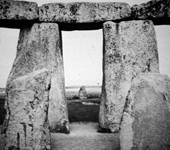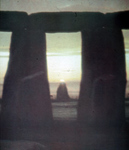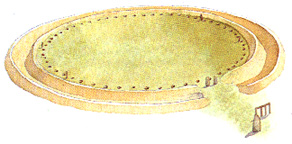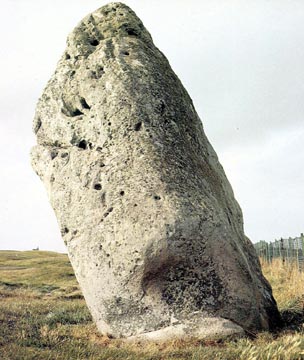
Already in the 18th century the British antiquarian William Stukeley (1687-1765) had noticed that the horseshoe of great Trilithons and the horseshoe of 19 Bluestones at Stonehenge opened up in the direction of the midsummer sunrise.
It was quickly surmised that the monument must have been deliberately oriented and planned so that on midsummer's morning the sun rose directly over the Heel Stone and the first rays shone into the centre of the monument between the open arms of the horseshoe arrangement.
 
View from the center of Stonehenge towards the Heel Stone, and a photograph of the sun rising over the Heel Stone
This discovery had a tremendous impact on how Stonehenge has been interpreted.
For Stukeley in the 18th century and for the British astronomer Sir Norman Lockyer (1836-1920) in the first years of the 20th century, the alignment implied a ritualistic connection with sun worship and it was generally concluded that Stonehenge was constructed as a temple to the sun.
More recently, though, the astronomer Gerald Hawkins has argued that Stonehenge is not merely aligned with solar and lunar astronomical events, but can be used to predict other events such as eclipses.
In other words, Stonehenge was more than a temple, it was an astronomical calculator.
It was argued that the summer solstice alignment cannot be accidental.
The sun rises in different directions in different geographical latitudes. For the alignment to be correct, it must have been calculated precisely for Stonehenge's latitude of 51° 11'.
The alignment, therefore, must have been fundamental to the design and placement of Stonehenge.
As if corroborating the claims made by Hawkins for Stonehenge, Alexander Thom (1894-1985), a professor of engineering and a mathematician, has shown that many other megalithic sites throughout Britain are also oriented towards the sun and the moon.
The alignment also made it clear that whoever built Stonehenge had precise astronomical knowledge of the path of the sun and, moreover, must have known before construction began precisely where the sun rose at dawn on midsummer's morning while standing on the future site of the monument.
This point must be stressed because with Stonehenge and many other such monuments, it was the site, a particular place within the landscape, that was important; only later were these sites marked in some more permanent manner by the digging of ditches and banks and (or instead) the erection of wood or stone structures.
For reasons we shall never know, this particular spot in the landscape was so important that not only were ditches and banks dug and, later, stone circles and horseshoe arrangements constructed to mark it, but that some of the stones were deliberately transported there with considerable effort from a great distance away.
Contrary to expectations, the great stone circles and horseshoe arrangements for which Stonehenge is famous were later additions to the monument (mostly Stonehenge III) and are not essential to the lunar and solar calculations.

Stonehenge: Phase I Image from Jean-Pierre Mohen The World of Megaliths (New York: Facts on File, 1990), page 131
Today Stonehenge I is barely noticed by visitors.
Standing far outside the massed standing stones of Stonehenge III, the remains are comprised of a circular ditch inside of which was erected a bank.
The bank is now eroded down to about a foot or so but can still plainly be seen.
There is little agreement on how high it was originally.
The diameter of the bank is 320 feet and it has at least one major break in it in the northeast, presumably to allow an uninterrupted view in the direction of the Heel Stone and the midsummer sun.
At least one other break is noticeable, and perhaps also a third. It should be noted that the break in the northeast is not quite aligned with the later horseshoe structures; nor is it quite aligned with the causeway beyond, or with the Heel Stone.

Heel Stone
Inside the bank were dug 56 holes - discovered by the English antiquarian John Aubrey (1626-1697), and known as the Aubrey Holes - placed at precisely regular intervals around a concentric circle of about 285 feet in diameter.
Archaeological investigations have shown that these holes were not dug to hold upright stones or wooden posts. Besides the Aubrey Holes, of crucial importance are the four Station Stones marked at positions 91, 92, 93, and 94, to form a rectangle that stands in a precise relationship with the centre of the monument and with the Heel Stone.
Only two of the Station Stones survive, and one of those may not be original.

Plan of Stonehenge with the Aubrey holes, the Heel Stone and the Station Stones 91, 92, 93, 94 marked Image from Rodney Castleden, The Making of Stonehenge (London and New York: Routledge, 1993), page 30
For the archaeoastronomists, the Aubrey Holes served as fixed reference points along a circle, and their number was essential to astronomical calculations. The cycle of the moon, for example, which takes 27.3 days, can be tracked by moving a marker by two holes each day to complete a circuit in 28 days.
A much longer calculation is to move the marker by three holes per year to complete a full circuit in 18.67 years.
In this way, it is argued, it would be possible to keep track of the nodes, points where the paths of the sun and the moon apparently intersect to produce an eclipse.
Because the moon slews around in its path, the two nodes move along the path of the sun, a complete circuit of which takes 18.61 years.
By means of the markers in the Aubrey Holes and keeping track of the directions of the sun and the moon, the astronomer at Stonehenge could calculate nodal points ahead of time and thus predict both lunar and solar eclipses.
Whether this was in fact the intended use of the Aubrey Holes is highly debatable.
In recent years astronomical interpretations have been taken up in support of more fanciful notions about the cosmic "New Age" significance of Stonehenge and contemporary "secular Druidism."
|
|
page online since October 10, 1996
revised August 22, 2001 modified February 19, 2002 modified again February 7, 2008 |


